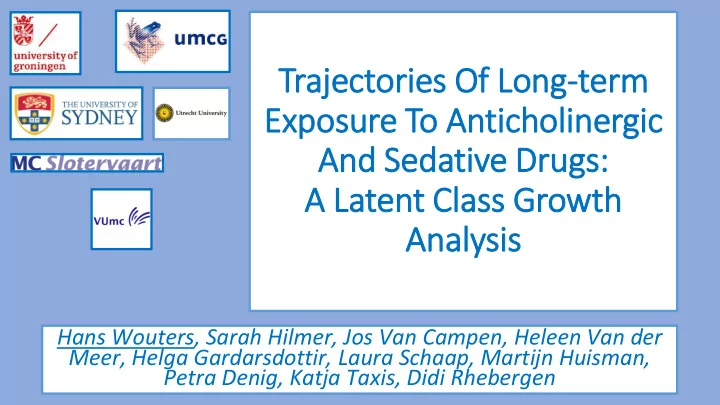

Traje jectories Of f Long-term Exposure To Antic icholi linergic And Sedativ ive Drugs: A Latent Cla lass Growth Analy lysis is Hans Wouters, Sarah Hilmer, Jos Van Campen, Heleen Van der Meer, Helga Gardarsdottir, Laura Schaap, Martijn Huisman, Petra Denig, Katja Taxis, Didi Rhebergen
CONFLICT OF INTEREST DISCLOSURE I have no potential conflict of interest to report
Problem definition & Study Aim
Ness et al., 2006, Am J Geriatr Pharm; Johnnell, 2009, Int J Geriatr Psychiatr
Approach
Longitudinal Aging Study Amsterdam (LASA) • A Dutch nationally representative cohort study • Of older community-dwelling adults aged 55-85 y • Data collection 20 years (1992-2012) at 7 occasions • Men and older people oversampled to counteract selective drop-out • Detailed assessment of drug use including verification with medication containers
D ∑ DBI = D + δ
Latent Class Growth Analysis #1 You start with a 1 trajectory model, then model with 2 trajectories, then 3….etc. #2 You inspect “Goodness of fit” statistics • Bayesian Information Criterion • Entropy • Bootstrapped Likelihood Ratio Test #3 Select the model with best “goodness of fit”
Results
Key data • N = 763 complete all follow-ups • 61% women • M age y 83 (SD 6) • M drugs prescribed 3.4 (SD 3.6) • Co-morbidity present: Heart Disease (40%) and Osteoarthritis (61%)
3 trajectories of exposure Stable High high Steep Gradual Increase increase moderate none 92/93 95/96 98/99 01/02 05/06 08/09 11/12
Conclusions
Three trajectories of long-term anticholinergic and sedative exposure were identified
Thank you Nous remercions l’organisation d’EUGMS d’avoir choisi notre résumé pour présentation
Recommend
More recommend